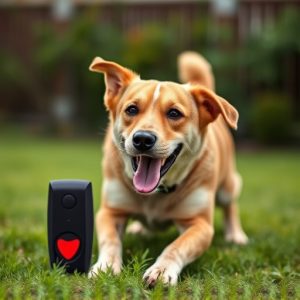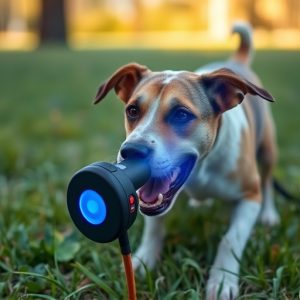Dog Repellent EMC Certification: Safety, Science, & Compliance Requirements
Dog repellents utilizing ultrasonic technology require Dog Repellent EMC Certification Requirements…….
Dog repellents utilizing ultrasonic technology require Dog Repellent EMC Certification Requirements to ensure safety and effectiveness, minimizing electromagnetic interference and protecting both humans and animals. This certification guarantees these devices won't disrupt other electronic equipment, making outdoor walks more enjoyable for pets and their owners while providing peace of mind. Manufacturers and importers must adhere to stringent international standards and rigorous testing processes to obtain this certification.
“Enhance your outdoor walking safety with ultrasonic dog repellents—a innovative solution that leverages technology. This article delves into the science behind Dog Repellent EMC Certification, a crucial standard ensuring device safety and effectiveness. We explore the significance of EMC Certification, its role in repelling dogs without harm, and provide a step-by-step guide to navigating the requirements. By understanding these key aspects, you’ll make informed choices for your walking safety.”
- Understanding Dog Repellent Technology: The Science Behind EMC Certification
- What is EMC Certification and Why is it Crucial for Dog Repellents?
- Dog Repellent Devices: Ensuring Safety and Effectiveness Through EMC Standards
- Navigating the Requirements: A Step-by-Step Guide to EMC Certification for Dog Repellents
Understanding Dog Repellent Technology: The Science Behind EMC Certification
Dog repellent technology has evolved significantly, and one key aspect is understanding the science behind Electronic Material Compatibility (EMC) certification. This certification ensures that devices emitting ultrasonic waves are safe for both humans and animals. The EMC requirements focus on minimizing electromagnetic interference, guaranteeing the product’s effectiveness won’t be compromised by external signals.
By adhering to these standards, dog repellents can offer reliable performance without causing harm. These safety measures are crucial in ensuring that walking your dog becomes a more enjoyable experience, free from unwanted animal encounters. Moreover, understanding EMC certification requirements empowers pet owners to make informed choices when selecting products for their furry companions’ well-being during outdoor walks.
What is EMC Certification and Why is it Crucial for Dog Repellents?
EMC (Electro-Magnetic Compatibility) Certification is a vital process that ensures electronic devices, like dog repellents, can operate safely and harmoniously in various environments without causing interference to other devices or vice versa. It’s a crucial standard for any product that emits or receives electromagnetic signals, especially in the context of consumer electronics. For dog repellents, EMC Certification is essential as it guarantees that the device won’t disrupt nearby technologies, like mobile phones or car electronics, and ensures these devices work optimally.
The EMC Certification process involves rigorous testing to meet specific requirements, including radio frequency (RF) emissions and immunity testing. These tests assess how well the dog repellent performs in the presence of electromagnetic interference (EMI). By adhering to EMC Certification requirements, manufacturers demonstrate that their products are safe, reliable, and won’t cause any adverse effects on users or surrounding electronics. This is particularly important for outdoor dog repellents, as they may be exposed to diverse electromagnetic environments.
Dog Repellent Devices: Ensuring Safety and Effectiveness Through EMC Standards
Dog repellent devices, designed to keep canines away from specific areas, often rely on ultrasonic technology. This method emits high-frequency sound waves that are typically inaudible to humans but can deter dogs. Ensuring the safety and effectiveness of such devices is paramount, especially when considering their potential impact on both pets and people. Herein lies the significance of EMC (Electromagnetic Compatibility) standards.
EMC certification requirements play a crucial role in gauging a dog repellent’s performance and safety. These standards assess how well the device performs in various electromagnetic environments while also protecting against interference from external sources. By adhering to EMC guidelines, manufacturers guarantee that their products are not only effective in repelling dogs but also safe for users and pets. Dog Repellent EMC Certification Requirements ensure that these devices operate within specified frequency ranges, avoiding potential harm or discomfort, thus providing peace of mind for those adopting such measures for walking safety.
Navigating the Requirements: A Step-by-Step Guide to EMC Certification for Dog Repellents
Navigating the complex landscape of EMC certification is essential for any dog repellent manufacturer or importer. The process involves understanding and adhering to stringent international standards designed to ensure electromagnetic compatibility (EMC) across electronic devices. Here’s a step-by-step guide to demystify this process.
First, familiarize yourself with relevant EMC directives such as the EU’s EMI/EMC Directive 2014/30/EU. These directives outline specific requirements based on the type of dog repellent and its intended use. Next, conduct thorough testing in accredited laboratories to assess immunity to electromagnetic interference (EMI) and ensure your product emits no harmful radiation. Once tests are passed, prepare technical documentation detailing design, manufacturing, and compliance processes. Finally, submit this documentation to a notified body for review, obtaining their certification mark once approved, which guarantees your dog repellent meets the stringent EMC Certification Requirements.
Ultrasonic dog repellents have evolved to ensure safe and effective walking experiences. By adhering to Dog Repellent EMC Certification requirements, manufacturers can guarantee their products’ performance and safety, addressing potential interference and ensuring a harmonious coexistence between humans and canine companions during outdoor walks. This certification process is vital for maintaining the reliability and sustainability of ultrasonic dog repellent technology.


